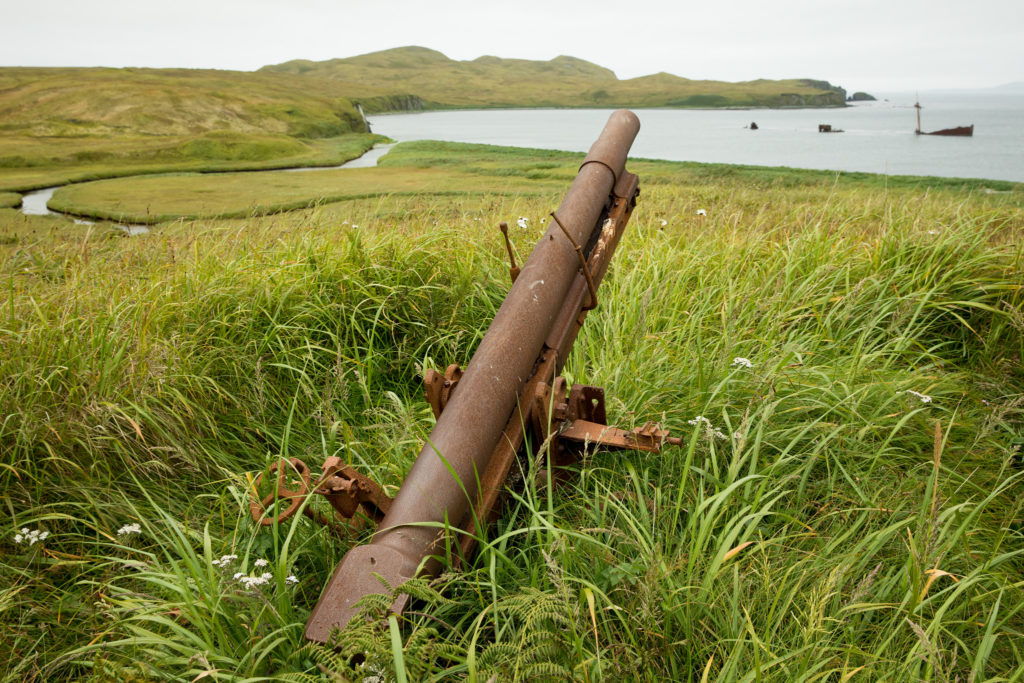How a mystery writer explained the way war profoundly shaped Alaska
Brian Garfield, who died last month, captured the significance of war in Alaska in “The Thousand Mile War: World War II in Alaska and the Aleutians” as few others could.

Every obituary about Brian Garfield made prominent mention — and rightly so — of a single book among the 70 or so he wrote during the decades he spent at the writer’s trade.
“Brian Garfield, a prolific suspense author best known for his novel ‘Death Wish,’ which became one of Hollywood’s longest-running film franchises, died on Dec. 29 at his home in Pasadena,” is how the New York Times began its account.
Garfield often said he never liked the violent series of movies that featured actor Charles Bronson as an enraged vigilante, but he told a group of Alaskans at a 1993 conference that “we love it when they film these horrible sequels and they have to send us a check.”
I was happy to see that most accounts of Garfield’s passing made mention of the book by him that is treasured by those with a passion for the history of the Far North — “The Thousand Mile War: World War II in Alaska and the Aleutians.”
This book is an essential guide to how the military transformed Alaska for all time, marked by early debates on strategy and Arctic geography that would shape U.S. national defense decisions for decades.
After nearly a half-century in print, Garfield’s history remains the best single volume on World War II in Alaska, a gripping account that is both readable and based on solid research.
The book continues to captivate new generations of readers with the astonishing details of what had long been known as the “Forgotten War” because so many were unaware that a war had been fought in Alaska in 1942-43.
Garfield, 79 at his death, once said he had long since lost count of exactly how many books he had written since “Range Justice,” a western that he wrote as a teenager, appeared in 1960.
He wrote many of his books quickly and had various pen names, some years turning out two or three books. During his lifetime, his books sold about 20 million copies and about 20 movies were based on his work.
In 1989, he told the Los Angeles Times that he had written “somewhere between 60 and 70” books, including mysteries, westerns, contemporary novels and nonfiction.
As the only person to have served as president of both the Western Writers of America and the Mystery Writers of America, he said he enjoyed the challenge of every genre.
“It drives my publishers and agent absolutely up the wall,” he said, “because they can’t typecast me.”
One of his professional rules was, “Don’t write anything you wouldn’t want to read.”
To that end he wanted to write a novel in 1966 about a bomber unit during World War II, but did not want to set it in England or the South Pacific, as those stories had been told.
He read a single paragraph in a history of the B-17 Flying Fortress about Alaska and World War II. He had never heard of the war in the Aleutians, but in two years of diligent work he became an authority on a part of Alaska history that had been largely buried in secret documents.
Through the efforts of the late Sen. Ernest Gruening, much of the material was declassified, leading him to contact hundreds of veterans of the Aleutian campaign. Garfield’s achievement opened the way for the many future writers and researchers who have examined the military history of the North.
He later wrote to one reader that the “subject matter grabbed me in a grip an ape couldn’t have pried loose. Compulsions like that don’t come along every day.”
Before the publication of “The Thousand-Mile War,” no one had told the comprehensive story of the war in Alaska, the only military campaign of World War II fought on North American soil.
The author took the name from the rough distance between Dutch Harbor, near the Alaska Peninsula, and the island of Attu, the western tip of the Aleutians.
Japan bombed Dutch Harbor in 1942 and occupied Attu and Kiska, triggering one of the most difficult campaigns of the war, in which the weather emerged as a common enemy.
It was the first offensive campaign by the U.S. during the war and became the first victory. Thousands died on each side.
In the meantime, the construction of the Alaska Highway through Canada, the deployment of hundreds of thousands of military personnel, and the construction of major military installations reshaped its political and social landscape.
One measure of Garfield’s lasting legacy is that when northern historians set out in 2006 to compile a list of the 67 best books ever written about Alaska, the committee unanimously agreed on just four books: Robert Fortuine’s “Chills and Fever,” Robert Marshall’s “Arctic Village,” Richard Pierce’s “Russian America: A Biographical Dictionary” and “The Thousand-Mile War: World War II in Alaska and the Aleutians.”
Alaska columnist and author Dermot Cole can be reached at [email protected].